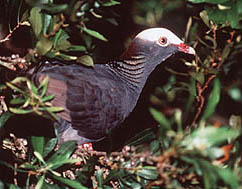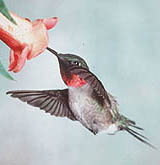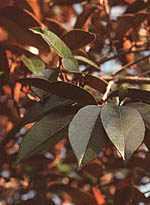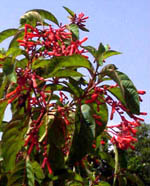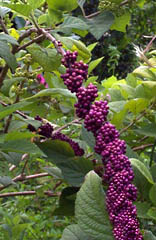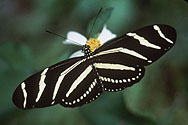Attracting Birds to Your Garden
by Roger L. Hammer
Plants which provide food and shelter will attract birds to your garden. Group them in one area of the garden, or intersperse them among existing plants. While native plants may not provide an extensive variety of colorful blossoms, you will find the wonderful array of birds and butterflies that visit your garden will more than compensate. Native plants are easy to care for, giving you time to relax and enjoy the birds and butterflies that are part of our South Florida heritage. Descriptions of bird-attracting plants follow. Most are available at local nurseries specializing in natives, while others can be obtained at Fairchild Tropical Botanic Garden plant shows and sales.
Large trees
Gumbo Limbo (Bursera simaruba), with its smooth, reddish, peeling bark, grows in the hardwood forests of South Florida. Flycatchers and other birds feed heavily on its small fruits. Eastern, Western and Gray Kingbirds, along with Great Crested and Scissor-tailed Flycatchers visit during March and early April.
Shortleaf fig (Ficus citrifolia) is a well-behaved ficus that produces an abundant supply of small figs savored by a wide variety of fruit-eating birds. Each spring, swarms of migrating Cedar Waxwings can be seen feeding on the fruit, which is also an important food source for the endangered White-crowned Pigeon. It is the larval food for the ruddy daggerwing butterfly.
Wild tamarind (Lysiloma latisiliquum) is perhaps the best warbler-attracting tree for our area. Numerous species of warblers, flycatchers, gnatcatchers and other insect-eating birds are attracted to the small moth caterpillars, young thornbugs and other small insects associated with wild tamarinds. Sweet-scented, white, mimosa-like flowers are produced from March through August.
Red bay (Persea borbonia), tends to be stunted in pinelands, but in wetter areas grows as large as oaks. The small, purple fruits are savored by a wide variety of birds. The leaves are the larval food of the palamedes swallowtail.
Live oak (Quercus virginiana), a stately native of southeastern United States, is a favorite of woodpeckers, especially the Yellow-bellied Sapsucker, as well as many other insect-eating birds. Ruby-throated Hummingbirds feed on the pollen. The leaves are the larval food of the gorgeous, iridescent blue white-M hairstreak, a fast-flying native butterfly, while the acorns are eaten by gray squirrels, blue-jays and woodpeckers.
Paradise tree (Simarouba glauca), has large, shiny green, compound leaves growing in clumps near branch tips, making it a stunning accent in the landscape. A male and a female tree are necessary to get the olive-shaped purple fruit so relished by birds.
Small to medium-sized trees
Torchwood (Amyris elemifera), has attractive maroon-colored new growth. The small, fleshy, aromatic fruit is eaten by birds. It is best known as the larval food plant for the exceedingly rare and endangered Schaus' swallowtail butterfly.
Bahama strongbark (Bourreria ovata) has downward-arching branches and fragrant, white flowers that attract Ruby-throated Hummingbirds. Later, numerous species of birds eagerly devour the showy, orange fruit that covers the trees.
Jamaica caper (Capparis cynophallophora) has shiny leaves that grow toward the tips of branches, leaving the interior open and providing a perfect nesting place for Mockingbirds, Cardinals and other native songbirds. The showy white or pink flowers produce slender, brown fruit which splits open to reveal a red-orange lining. The large, brown seeds are distributed by birds.
Satinleaf (Chrysophyllum oliviforme) has rust-colored, satiny pubescence on the undersides of its leaves. Dark purple fruit is edible when fully ripe, and relished by fruit-eating birds.
Coffee colubrina (Colubrina arborescens) produces clusters of tiny greenish flowers which give off a sweet odor detectable from great distances, attracting an abundance of insects, mainly nectar-seeking bees and wasps. Flycatchers, gnatcatchers and warblers abound during its extensive flowering season, taking advantage of the cornucopia of insects drawn to the flowers.
Geiger tree (Cordia sebestena) produces clusters of bright orange to red-orange flowers from fall through spring. Hummingbirds can be found darting from flower to flower, taking advantage of the abundant nectar. Stoppers excel as bird attractors because of their small, fleshy fruits. They work well in group plantings and thickets, or as border plants under large trees. The white flowers, although short-lived, are good butterfly-attractors.
Pineland privet (Forestiera segregata var. pinetorum) is a delicate-appearing many-branched tree. Male and female plants are required to fruit. The small fruit appears in clusters on older branches and is eaten by numerous species of birds.
Firebush (Hamelia patens) excels in full sun as a colorful bird and butterfly attractor. Tubular, reddish-orange flowers are produced virtually every day of the year. The flowers are a favorite of hummingbirds and butterflies.
Red mulberry (Morus rubra) produces red to dark purple fruit in April and May which is a favorite of many birds. The leaves drop in early winter, and the branches remain bare until late winter or early spring.
Wax myrtle (Myrica cerifera) is common in South Florida's pinelands and swamplands. The female tree bears copious quantities of small, BB-sized, waxy fruits that are savored by numerous birds, especially Tree Swallows and Yellow-rumped Warblers.
Potato tree (Solanum erianthum), a weedy tomato relative, is not cultivated, but is easily grown from seed collected in the wild. The non-edible, tomato-like yellow fruit is gulped whole by a variety of birds, and is one of the favorite foods of the red-bellied woodpecker.
Shrubs
Beautyberry's (Callicarpa americana) rounded, pink flower clusters produced at leaf axils are followed by very showy, tight clusters of lavender fruit. Butterflies are drawn to the flowers, while birds, especially mockingbirds, feed on the fruit.
Bird pepper (Capsicum annuum var. glabriusculum), a petite shrub, produces an abundant supply of small, fiery-hot, red peppers. Mockingbirds and Catbirds are very partial to the fruit.
Bahama cassia (Senna chapmanii) produces clusters of bright yellow flowers which are frequently visited by butterflies. The leaves are the larval food for the orange-barred sulphur, a common butterfly in our area. Birds occasionally feed on the caterpillars.
Butterfly sage (Cordia globosa var. humilis), a tight, rounded shrub, produces small, cup-shaped, white flowers that attract a wide variety of butterflies. Many insects find the flowers to their liking, including small, nectar-feeding wasps and some species of flies (not house flies). With so much insect activity, birds dart around, feeding on the bounty. Fruit-eating birds are attracted to the small, bright red fruit.
Lantana occurs in several native species. All are superb butterfly-attractors, and birds feed on the fruit of all.
Mangrove mallow (Pavonia spicata), is a sprawling shrub in the wild, but cultivated plants are more upright. The green hibiscus-like flowers are superior hummingbird-attractors.
Wild coffee (Psychotria spp.) occurs in three species native to Florida:
- P. nervosa, with dark green, shiny leaves
- P. sulzneri, with dull, satiny leaves and smaller fruit
- and P. ligustrifolia, with still smaller leaves.
All have white flowers that attract butterflies, especially ruddy daggerwings. The red fruit on all species is eaten by birds.
Southern sumac (Rhus copallina var. leucantha) has small compound leaves with a winged rachis. Birds feed on the tight clusters of small, reddish fruit borne on the branch tips of female trees.
Bloodberry (Rivina humilis) is common in open areas of hammocks. Each branch is tipped with a spike of small, brilliant red fruit fed on by numerous species of birds.
Necklace pod (Sophora tomentosa) is a leggy shrub with arching branches tipped with a long spike of butter-yellow, pea-like flowers and silvery compound leaves. Hummingbirds love it, and it is the larval food for the small cassius blue butterfly.
Palms
Most of our native palms produce small fruit that is attractive to a wide variety of birds, including exotic parrots. An exception is our native saw palmetto, Serenoa repens, which produces fruit too large for most birds. Saw palmetto does offer good cover and its strongly fragrant flowers are attractive to honeybees and small butterflies, especially the Florida atala. Plant it around your yard as a border plant or in thickets as it appears in nature. Other Florida native palms for consideration are:
- Paurotis palm (Acoelorrhaphe wrightii)
- Silver palm (Coccothrinax argentata)
- Royal palm (Roystonea elata)
- Scrub palm (Sabal etonia)
- Dwarf cabbage palm (Sabal minor)
- Brittle thatch palm (Thrinax morrisii)
- Jamaica thatch palm (Thrinax radiata)
Ground covers
Ground covers can be used to fill in open spaces in the landscape. Tall ground covers can be used in some areas, while other spots may require low-growing species.
- Butterfly weed (Asclepias tuberosa)
- Quail-berry (Crossopetalum ilicifolium)
- Golden creeper (Ernodea littorali)
- Lantana (Lantana depressa) (one foot)
- Wild petunia (Ruellia caroliniensis)
- Blue porterweed (Stachytarpheta jamaicensis)
- Fakahatachee grass (Tripsacum dactyloides)
- Dwarf Fakahatchee grass (Tripsicum floridanum)
- Coontie (Zamia pumila)
Roger L. Hammer is a supervisor for Natural Areas Resource Management for Miami-Dade County. He is also a popular instructor in the Garden's adult education program.


